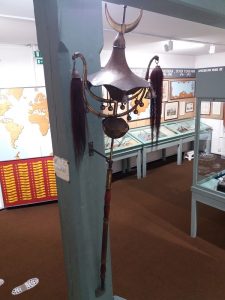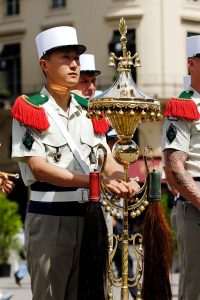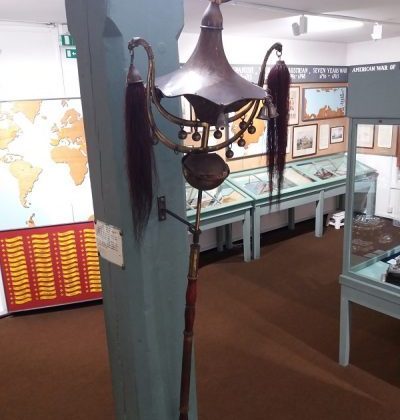The use of musical instruments for signalling has been a core part of military campaigns throughout history. Though drums are no longer used in this way, bugles are still used as a call throughout an infantryman’s day, and drums and bugles feature strongly in regimental bands. We have a number of drums and bugles in our collection which have been used for signalling on the battlefield, or to mark the time of day. We have a fantastic Lucknow Drum and many beautiful bugles – some of which are available for visitors to have a go on!
One of the more unusual instruments in our collection is The Jingling Johnny. Alternatively known as a Turkish Crescent, the instrument was traditionally used by the Turkish military Janissary (an elite infantry unit) band in the 18th century which sparked a trend in Europe for Turkish inspired music.

The rather exotic-looking instrument is comprised of a long stick, with a canopy (a ‘pavillon’ in French, giving rise to one of the French names for the instrument, Pavillon Chinois), from which is hung a series of bells, which create the musical sounds. Though designs of the instrument vary, our example has a sphere below the canopy and a Turkish crescent above.
In the 19th century British military bands had adopted it as part of their ensemble. Our example was used by the Band of the 46th Regiment of Foot when fighting in Crimea in 1854. The history of our instrument prior to its use during this period is unclear, though it is thought that it is either a British example, or one given to the regiment by our allies during the Crimean War.
Jingling Johnnys continue to be used today, either for music or with a ceremonial purpose, by a range of military marching bands in Europe.

Chapeau Chinois (Jingling Johnny) in use by French Foreign Legion
NEW EXHIBITION
Music, Military & Morale
Learn more about the role of music in the military with our upcoming exhibition designed by our Citizen Curators: Music, Military, Morale explores the role of music in the military and its relationship with civilian life, morale, recruitment and Cornish identity.
Opens to the public April 13th 2019
Entry included in usual admission price


